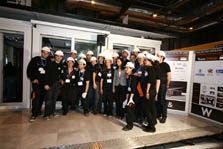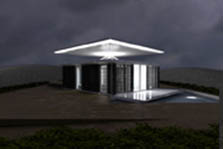

The enthusiastic Universidad Politécnica de Madrid team wanted to create something totally different from past entries—and has succeeded.

The glass inverted-pyramid on top of the Team Spain house automatically tracks the sun for highest efficiency by the PV system and solar water heating collectors on its upward-facing base.
Download
Construction Drawings (Zip 107 MB)
Project Manual (Zip 18 MB)
Neither the United States, nor the Department of Energy, nor the Alliance for Sustainable Energy LLC, nor any of their contractors, subcontractors, or their employees make any warranty, express or implied, or assume any legal liability or responsibility for the accuracy, completeness, or usefulness for any purpose of any technical resources or data attached or otherwise presented here as reference material.
Solar Decathlon 2009
Team Spain
Universidad Politécnica de Madrid
Sigue el Sol—Follow the Sun
Make a squat pyramid of glass, invert it base up, and install both photovoltaic (PV) panels and solar water heating collectors in the upward-facing base. Next, set the tip of the pyramid on a ball-and-socket mechanism pivoted by a solar tracking system like a very slowly spinning or tilting toy top. Put this on top of a house, and you have the essence of the unique Team Spain U.S. Department of Energy Solar Decathlon 2009 entry.
The Team
Graduating architecture student Irene Garrido says the Solar Decathlon experience is a "dream come true"—a sentiment her teammates were quick to echo—and that energy efficiency is not just a trend but something she believes in. Although the Team Spain is dominated by architecture students, it does include engineers and others, as evidenced by the technically challenging solar-tracking roof it developed.
The House
The team characterizes its house style as "very, very modern." Team members call it the "Black and White House, but with an orange touch of color" because it meets the yin and yang of high efficiency and comfortable living. There is a separate kitchen-bath-utilities module and a sun room for passive solar heating, but otherwise, all the living and sleeping area is provided by a single large, multifunctional space. A combination of daylighting, partially reflected through skylights in the house's pyramid top, and LED (light-emitting diode) lights, programmed to simulate dawn or dusk or be turned on by an alarm clock, give this house a special feel.
The Madrid Solar Decathlon 2005 entry was a Mediterranean-style house, and in 2007, it was a rectangular house, so the 2009 team felt it had to "do something completely different."
The Technology
The solar-tracking inverted pyramid top is the most notable technology of the house, but other systems include:
- A 14.9-kW crystalline silicon PV system in the pyramid base for electrical production
- Solar water heating collectors (also in the pyramid base) for domestic hot water and in-floor radiant heating
- Passive solar heating by a glass conservatory and thermal management by structural insulated panels and phase-change materials
- Supplemental heating and cooling by a ground-source heat pump. (Water tanks will substitute for the ground while the house is on the National Mall.)
House Highlights
- A squat glass pyramid inverted base up that pivots to track the sun
- A passive solar conservatory, a kitchen-bath-utility module, and a large multifunctional great room for living and sleeping
- An easy-to-move and easy-to-expand home for 40–50-year-olds outside the urban area
- A solar-tracking top roof that may be the first of its kind (The university has filed for a patent on the ball-and-socket, central-pivot system that makes it possible.)
